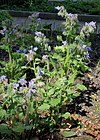Note: This is a project under development. The articles on this wiki are just being initiated and broadly incomplete. You can Help creating new pages.
Difference between revisions of "Borago officinalis"
| Line 71: | Line 71: | ||
<ref name="chemical composition">["chemistry"]</ref> | <ref name="chemical composition">["chemistry"]</ref> | ||
<ref name="Leaf">["morphology"]</ref> | <ref name="Leaf">["morphology"]</ref> | ||
| − | <ref name="How to plant/cultivate">[ | + | <ref name="How to plant/cultivate">[http://temperate.theferns.info/plant/Borago+officinalis Cultivation]</ref> |
</references> | </references> | ||
==External Links== | ==External Links== | ||
| − | * [ ] | + | * [https://pfaf.org/user/Plant.aspx?LatinName=Borago+officinalis Borago officinalis on pfaf.org] |
| − | * [ ] | + | * [http://gernot-katzers-spice-pages.com/engl/Bora_off.html Borago officinalis on spice-pages.com] |
| − | + | ||
[[Category:Herbs]] | [[Category:Herbs]] | ||
[[Category:Pages without herbs images]] | [[Category:Pages without herbs images]] | ||
Revision as of 20:32, 3 April 2020
Borago officinalis is an erect to spreading, annual to biennial plant. It can grow up to 60cm tall. Borage has a wide range of uses as a culinary and medicinal herb. It can be harvested from the wild it is more commonly cultivated in the herb garden. Various named forms have been developed.
Contents
- 1 Uses
- 2 Parts Used
- 3 Chemical Composition
- 4 Common names
- 5 Properties
- 6 Habit
- 7 Identification
- 8 List of Ayurvedic medicine in which the herb is used
- 9 Where to get the saplings
- 10 Mode of Propagation
- 11 How to plant/cultivate
- 12 Commonly seen growing in areas
- 13 Photo Gallery
- 14 References
- 15 External Links
Uses
Fevers, Chest problems, Kidney problems, Liver problems, Inflammatory swellings, Lowers blood pressure, Skin complaints.
Parts Used
Chemical Composition
Common names
| Language | Common name |
|---|---|
| Kannada | |
| Hindi | |
| Malayalam | |
| Tamil | |
| Telugu | |
| Marathi | |
| Gujarathi | |
| Punjabi | |
| Kashmiri | |
| Sanskrit | |
| English |
Properties
Reference: Dravya - Substance, Rasa - Taste, Guna - Qualities, Veerya - Potency, Vipaka - Post-digesion effect, Karma - Pharmacological activity, Prabhava - Therepeutics.
Dravya
Rasa
Guna
Veerya
Vipaka
Karma
Prabhava
Habit
Identification
Leaf
| Kind | Shape | Feature |
|---|---|---|
Flower
| Type | Size | Color and composition | Stamen | More information |
|---|---|---|---|---|
| {{{5}}} |
Fruit
| Type | Size | Mass | Appearance | Seeds | More information |
|---|---|---|---|---|---|
Other features
List of Ayurvedic medicine in which the herb is used
Where to get the saplings
Mode of Propagation
How to plant/cultivate
A very easily grown plant, succeeding in ordinary garden soil preferring a dry soil.[3]
Commonly seen growing in areas
Photo Gallery
References
- ↑ ["chemistry"]
- ↑ ["morphology"]
- ↑ Cultivation
External Links
- Ayurvedic Herbs known to be helpful to treat Fevers
- Ayurvedic Herbs known to be helpful to treat Chest problems
- Ayurvedic Herbs known to be helpful to treat Kidney problems
- Ayurvedic Herbs known to be helpful to treat Liver problems
- Ayurvedic Herbs known to be helpful to treat Inflammatory swellings
- Ayurvedic Herbs known to be helpful to treat Lowers blood pressure
- Ayurvedic Herbs known to be helpful to treat Skin complaints
- Herbs with Leaves used in medicine
- Herbs with Dried stem used in medicine
- Herbs with Flower used in medicine
- Habit - Biennial
- Index of Plants which can be propagated by Seeds
- Herbs that are commonly seen in the region of Waste ground
- Herbs
- Pages without herbs images







